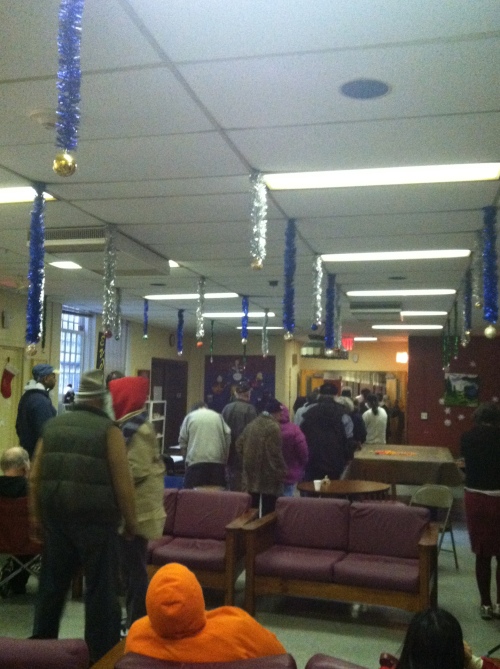
Belle Harbor Manor residents line up to receive their monthly allowance despite allegations that they are paying rent while living in shelter on the campus of a psychiatric facility in Queens. Photo: Kristine Rakowsky
NY Homes For Elderly Under Scrutiny After Sandy
by The Associated Press
NEW YORK (AP) — A nursing home and an assisted living facility are under scrutiny by state officials and an advocacy group after The Associated Press disclosed that hundreds of elderly and disabled people forced to evacuate by Superstorm Sandy were still sleeping on cots in cramped and sometimes oppressive conditions almost two months later.
New York’s attorney general sent two investigators to the Bishop Henry B. Hucles Episcopal Rehabilitation and Skilled Nursing Center in Brooklyn last week after the AP reported that the home was swollen to nearly double its 240-bed licensed capacity with evacuees from the storm-damaged Rockaway Care Center on the Queens seashore.
As of Christmas, many of those patients were still sleeping, field-hospital style, on rows of cots squeezed into community rooms, a rehabilitation gym and the nursing home’s tiny chapel.
The state’s Office of Long Term Care Ombudsman also dispatched a representative to check on conditions. State Health Department officials were independently investigating how one patient walked out of the facility unnoticed on a cold Friday night, only to turn up at a hospital two days later.
Separately, a legal aid group, MFY Legal Services, is questioning why disabled and elderly residents of Belle Harbor Manor, an adult care home in Queens, were still being asked to sign over most of their monthly Social Security checks to the facility to cover room and board even though they have been flooded out of their rooms since Halloween.
After the storm, those residents were sent to an emergency shelter, then to an overcrowded hotel, and finally to a halfway house for the mentally ill. During that time, many residents have continued to pay rent to Belle Harbor Manor.
“We haven’t had any services in the last three months. But he has been getting our rent. What I want to know is, ‘Where is this money going?'” asked resident Alex Woods, 57. “After what we went through, he should be paying us.”
MFY senior lawyer Shelly Weizman said it isn’t clear whether residents are legally obligated to keep paying when they have effectively been evicted by the storm.
At Belle Harbor and many other adult care homes in New York, residents sign an agreement when they first arrive that obligates them to turn over their Social Security checks to the facility, which uses most of the money to cover housing and care. Administrators return a small portion to the residents in the form of an allowance.
Now, Weizman said, “they are paying, but they aren’t getting the services. It is a confusing situation.”
Residents got their latest benefit checks on Jan. 3. A few did decide to withhold their January rent payment, which for many residents was around $1,200, Weizman said.
The phone rang unanswered Friday in the administrative office at Belle Harbor Manor, as it has since the storm. The president of the nonprofit company that controls the home, Samuel Aschkenazi, declined to talk with the AP and referred questions to another board member, who didn’t return messages or answer his telephone. The home’s accountant also did not return calls.
A spokeswoman for Episcopal Health Services, which owns the Bishop Hucles nursing home, said administrators expect the state will give the Rockaway Care Center approval to reopen in about a week, clearing the way for patients to return.
In the meantime, the number of evacuees staying at Bishop Hucles has dropped from 187 to 136, said the spokeswoman, Penny Chin. She said that the state Health Department had been aware from the start that the nursing home had taken on so many extra patients, and had approved the situation.
More than 6,200 people were evacuated from 47 nursing and adult care homes because of the Oct. 29 storm, according to state health officials. At least hundreds are still displaced, living in different nursing homes or other temporary facilities.
Several of the Belle Harbor evacuees, who are a mix of the elderly and people with mild psychiatric disorders, told the AP that they have found the staff at the halfway house kindly, but the setting isolating and overly restrictive. They cannot have visitors in their rooms. Most haven’t been able to retrieve their belongings from Belle Harbor.
It was unclear when residents might return to Belle Harbor, which is undergoing a gut renovation and replacing heating, electrical and fire suppression systems ruined in the flood. New York City’s Buildings Department inspected it Friday and concluded that the work was about halfway done.
“They had been telling people they were going home in a week,” said Kristine Rakowsky, a volunteer who has been serving as an advocate for the residents, visiting them daily and trying to help them with needs such as fresh clothing and medical supplies. “Now there is no end in sight.”
